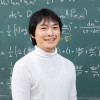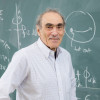セミナー
784 イベント
-
セミナー

Simple models of cancer growth, MCMC parameter estimation and identifiability
2021年4月8日(木) 10:00 - 11:00
カトゥリン・ボシゥメン (理化学研究所 数理創造プログラム (iTHEMS) 副プログラムディレクター / Professor, Department of Physics, Ryerson University, Canada)
I would like to introduce some basic concepts about (very simple) mathematical model of cancer growth, the basic math behind parameter estimation via Markov chain Monte Carlo (MCMC) based on Bayes' theorem, and the different diagnostics you can use to know if the parameters are correctly estimated. I will use a recent example with cancer data in mice. I think this seminar can be interesting to mathematicians (because of the models and the math behind the parameter estimation, but the math is very basic!), to physicists (especially those that have to do some parameter estimation), and to biologists (the cancer model/data and the parameter estimation). I think it will also be interesting to the information theory and prediction science people. MCMC parameter estimation based on physical models is more valuable in my field than machine learning, so I think those interested in machine learning but maybe are not so familiar with MCMC should join to consider them as an alternative approach in certain contexts. *Please refer to the email to get access to the Zoom meeting room.
会場: via Zoom
イベント公式言語: 英語
-
セミナー
Long-time behavior of moving solids in a fluid and the kinetic theory of gases
2021年4月7日(水) 16:00 - 18:10
小池 開 (京都大学 工学研究科 特別研究員)
Understanding dynamics of solids in a fluid is a fundamental problem in fluid dynamics. Due to the growing interest in engineering in out-of-equilibrium situations, moving boundary problems for kinetic equations such as the Boltzmann equation have become an active area of research. In the first part of the talk, I shall explain recent, especially mathematical, developments in this field. Then in the second part, I'd like to explain my results concerning the long-time behavior of a point particle moving in a 1D viscous compressible fluid. These results aim to give some explanation of related numerical simulations for a BGK model of the Boltzmann equation.
会場: via Zoom
イベント公式言語: 英語
-
セミナー

Structural reduction of chemical reaction networks based on topology
2021年4月1日(木) 10:00 - 11:00
広野 雄士 (Junior Research Group Leader/Assistant Professor, Research Division, Asia Pacific Center for Theoretical Physics, Republic of Korea)
Chemical reactions form a complex network in living cells and they play vital roles for physiological functions. An amusing question is how the structure of a reaction network is linked to its chemical functionalities. I’ll talk about a method of the reduction of chemical reaction networks, which is convenient for extracting important substructures. Mathematical concepts such as homology and cohomology groups are found to be useful for characterizing the shapes of reaction networks and for tracking the changes of them under reductions. For a given chemical reaction network, we identify topological conditions on its subnetwork, reduction of which preserves the steady state of the remaining part of the network.
会場: via Zoom
イベント公式言語: 英語
-
セミナー

Evolutionary conservativeness and diversification of cycads: Understanding the evolution of living fossils
2021年3月25日(木) 10:00 - 11:00
ホセ サイード・グティエレス オルテガ (千葉大学 国際未来教育基幹 助教)
The cycads are a lineage of gymnosperms that represent an example of biological stasis success. Despite their early origin in the seed plant evolution, they survived multiple events of mass extinction and could diversify in modern tropical ecosystems during the Cenozoic, especially in countries known for their great biodiversity such as Mexico. What factors have allowed their persistence and diversification despite their conservative nature? I have studied the cycad genus Dioon, a group of 17 species occurring in habitats ranging from tropical forests to arid zones in Mexico and Honduras. Phylogenetic and phylogeographic analyses revealed that the diversification of Dioon has been driven by the long-term process of aridification of Mexico since the Miocene. The lineages that shifted from mesic forests to arid zones show leaf trait variations beneficial against water stress; this feature can be also observed at the inter-population level when comparing mesic versus arid sister pairs. What mechanism allows this aridification-driven diversification? Using population genetics and ecological niche modeling on sister lineage pairs, I have revealed that lineages at arid zones might tolerate arid environments, but within the arid habitat, they retain the same ancestral niche also observed on their mesic sisters. The surrounding areas that are suboptimal for their niches serve as barriers against gene flow: this promotes allopatric speciation. This research has revealed that the mechanism that allows the diversification process in Dioon involves three factors: 1) a habitat shift due to aridification, 2) niche conservatism that facilitates geographic isolation, 3) gaining unique morphological and anatomical features that help to counteract water stress, probably through long-term stabilizing selection. This research highlights the importance of biological conservatism in evolution, and how “living fossils” can still diversify into modern ecosystems.
会場: via Zoom
イベント公式言語: 英語
-
セミナー

Journal Club: Reinforcement Learning
2021年3月24日(水) 13:00 - 14:00
田中 章詞 (理化学研究所 数理創造プログラム (iTHEMS) 上級研究員)
Reinforcement Learning (RL) is a scheme of Machine Learning that is applicable "without training data." Instead, we prepare a "world" that agents (learners) can probe, and try to optimize their behavior. Historically, study of RL has deep connection to studies of psychology and neuroscience. In this journal club, I would like to give a lightning review of RL. *Detailed information about the seminar refer to the email.
会場: via Zoom
イベント公式言語: 英語
-
セミナー
The Green-Tao theorem for number fields
2021年3月22日(月) 16:00 - 18:10
甲斐 亘 (東北大学 理学部数学科 助教)
5, 11, 17, 23, 29 are prime numbers which form an arithmetic progression of length 5. A famous theorem of Ben Green and Terence Tao in 2008 says there are arbitrarily long arithmetic progressions of prime numbers. Algebraic number theorists are also interested in more general numbers like square roots of integers. Recently, Mimura, Munemasa, Seki, Yoshino and I have established a generalization of the Green-Tao theorem in such a direction. In the first 50 minutes of my talk, I would like to explain some background and technology behind the Green-Tao theorem. In the second half after a break, I explain the concept of number fields to formulate our generalization of their result. I will also discuss how one of the new difficulties, which I call the norm vs length conflict, is handled by a technique called Geometry of Numbers. *Please contact Keita Mikami or Hiroyasu Miyazaki's mailing address to get access to the Zoom meeting room.
会場: via Zoom
イベント公式言語: 英語
-
セミナー
Geometric nonlinear optical effects
2021年3月16日(火) 17:00 - 18:15
森本 高裕 (東京大学 大学院工学系研究科 物理工学専攻 准教授)
Time: 5pm ~ 6:15pm (JST); 9am ~ 10:15am (CET) The responses of materials to high intensity light, i.e., nonlinear optical responses, constitute a vast field of physics and engineering. While geometry and topology has been playing a central role in recent studies of condensed matters, geometrical aspects of nonlinear optical effects have not been fully explored so far. In this talk, I will show a few examples of nonlinear optical effects that have geometrical origins. First, I present that the second-order nonlinear optical effects including the shift-current, a candidate mechanism for recently discovered solar cell action in perovskite materials, has a close relationship to the modern theory of polarization, and is described by the Berry connection of Bloch wave function [1]. I will also discuss how electron correlations can enhance/modify shift current response in inversion broken materials. Next, I show that another second-order nonlinear effect, circular photogalvanic effect (CPGE), is governed by Berry curvature and shows quantization in Weyl semimetals [2]. I will report a recent measurement on chiral multifold fermion RhSi that observed a plateau structure in CPGE which is consistent with the expected quantization [3].
会場: via Zoom
イベント公式言語: 英語
-
セミナー
Microeconomics of metabolism
2021年3月10日(水) 10:00 - 11:00
山岸 純平 (東京大学 金子研究室 博士課程)
Metabolic behaviors of proliferating cells are often explained as a rational choice to optimize cellular growth rate. In contrast, microeconomics formulates consumption behaviors as optimization problems of utilities. We pushed beyond this analogy to precisely map metabolism onto the theory of consumer choice. We thereby revealed the correspondence between and a general mechanism for mysteries in biology and economics: the Warburg effect, a seemingly-wasteful but ubiquitous phenomenon where cells favor aerobic glycolysis over more energetically-efficient respiration, and Giffen behavior, the unexpected consumer behavior where a good is demanded more as its price rises. The correspondence implies that respiration is counterintuitively stimulated when its efficiency is decreased by drug administration. This “microeconomics of metabolism” will serve as a macroscopic phenomenology to predict the metabolic responses against environmental operations. In particular, it offers a universal relationship between the metabolic responses against drug administrations and changes in nutrient availability.
会場: via Zoom
イベント公式言語: 英語
-
セミナー
Exceptional Topology of Non-Hermitian Systems: from Theoretical Foundations to Novel Quantum Sensors
2021年3月3日(水) 17:00 - 18:15
Jan Budich (Professor, Quantum Many-Body Physics, TU Dresden, Germany)
CET: 9:00a.m. - 10:15a.m. on March 3, 2021 JST: 5:00p.m. - 6:15p.m. on March 3, 2021 EST: 3:00a.m. - 4:15a.m. on March 3, 2021 In a broad variety of physical scenarios ranging from classical meta-materials to open quantum systems, non-Hermitian (NH) Hamiltonians have proven to be a powerful and conceptually simple tool for effectively describing dissipation. Motivated by recent experimental discoveries, investigating the topological properties of such NH systems has become a major focus of current research. In this talk, I give an introduction to this rapidly growing field, and present our latest results. Specifically, we discuss the occurrence of novel gapless topological phases unique to NH systems. There, the role of spectral degeneracies familiar from Hermitian systems such as Weyl semimetals is played by exceptional points at which the effective NH Hamiltonian becomes non-diagonalizable. Furthermore, we show how guiding principles of topological matter such as the bulk boundary correspondence are qualitatively changed in the NH realm. Finally, we demonstrate that the sensitivity of NH systems to small changes in the boundary conditions may be harnessed to devise novel high-precision sensors. *Detailed information about the seminar refer to the email.
会場: via Zoom
イベント公式言語: 英語
-
セミナー

Origin of non-linearity of large deformation on DNA stretched
2021年2月25日(木) 10:00 - 11:00
横田 宏 (理化学研究所 数理創造プログラム (iTHEMS) 特別研究員)
Since DNA in a cell is mechanically stretched or rotated by many proteins, the mechanical response of DNA in vitro is expected to be basic point for understanding its behavior. When DNA is stretched by relatively high force, the length of DNA shows the nonlinear response. In this talk, I introduce the theoretical treatment of DNA stretching in high force region based on polymer physics.
会場: via Zoom
イベント公式言語: 英語
-
セミナー

The Evolution of Primordial Neutrino Helicities under Gravitational and Magnetic Fields and Implications for their Detection
2021年2月22日(月) 10:00 - 11:30
ゴードン・ベイム (理化学研究所 数理創造プログラム (iTHEMS) 客員主管研究員 / Professor Emeritus, University of Illinois, USA)
Feb.22 (Mon) 10:00am-11:30am (JST) Primordial neutrinos decoupled in the early universe in helicity eigenstates. As I will discuss, two effects -- dependent on neutrinos having a non-zero mass -- can modify their helicities as they propagate through the cosmos. First, finite mass neutrinos have a magnetic moment and thus their spins, but not their momenta, precess in cosmic and galactic magnetic fields. The second is the propagation of neutrinos past cosmic matter density fluctuations, which bend their momenta, and bend their spins by a smaller amount. (The latter is a general relativistic effect.) Both effects turn a fraction of left-handed neutrinos into right-handed neutrinos, and right-handed antineutrinos into left-handed. If neutrino magnetic moments approach that suggested by the XENON1T experiment as a possible explanation of their excess of low energy electron events -- a value well beyond the moment predicted by the standard model -- helicities of relic Dirac (but not Majorana) neutrinos could be considerably randomized. I finally will discuss the implications of neutrino helicity rotation, as well as their Dirac vs. Majorana nature, on their detection rates via the Inverse Tritium Beta Decay reaction.
会場: via Online
イベント公式言語: 英語
-
セミナー
High-throughput laboratory evolution with machine learning reveals constraints for drug resistance evolution
2021年2月18日(木) 10:00 - 11:00
岩澤 諄一郎 (東京大学 大学院理学系研究科物理学専攻 博士課程)
The understanding of evolution is crucial to tackle the problem of antibiotic resistance which is a growing health concern. Although the lack of sufficient data has long hindered the mechanism of evolution, laboratory evolution experiments equipped with high-throughput sequencing/phenotyping are now gradually changing this situation. The emerging data from recent laboratory evolution experiments have revealed repeatable features in evolutionary processes, suggesting the existence of constraints on evolutionary outcomes [1,2]. Despite its importance for understanding evolution, however, we still lack a systematic investigation for evolutionary constraints. In this seminar, I would like to talk about two projects on the investigation of evolutionary constraints using data acquired from laboratory evolution of Escherichia coli. In the first half, I will explain how to extract an effective latent space for probing constraints in resistance evolution using gene expression data. We will further discuss what kind of structure exists in this space [3]. In the latter half, I will talk about our recent study on how to construct a predictive model for evolution using the information of evolutionary constraints.
会場: via Zoom
イベント公式言語: 英語
-
セミナー

Journal Club: Large deviation statistics of Markovian quantum systems
2021年2月17日(水) 13:00 - 14:30
濱崎 立資 (理化学研究所 数理創造プログラム (iTHEMS) 上級研究員 / 理化学研究所 開拓研究本部 (CPR) 濱崎非平衡量子統計力学理研白眉研究チーム 理研白眉研究チームリーダー)
Large deviation is a mathematical framework to treat “rare events” in random processes [1]. In this journal club, I talk about recent development of large deviation analysis in open Markovian quantum systems [2,3]. I first introduce the notion of large deviation statistics using the simple independent and identically distributed random variables. I then review recent development of level 2.5 large deviation statistics for classical Markovian jump processes and its application to thermodynamic uncertainty relation [4]. Finally, I discuss how the classical results are extended to quantum regime. *Detailed information about the seminar refer to the email.
会場: via Zoom
イベント公式言語: 英語
-
セミナー
Mapping the Milky Way by VLBI Astrometry
2021年2月16日(火) 13:30 - 15:00
坂井 伸行 (Korea Astronomy and Space Science Institute (KASI), Republic of Korea)
Astrometry is the only way to obtain 6D (position-velocity) phase space information for astronomical objects. The unique capability allows us to examine the past, present, and future of the Milky Way. Firstly, I will introduce history and basics of astrometry. Secondly, I will overview astrometric projects in the world. Thirdly, I will highlight recent astrometric results about the Galactic structure. Lastly, I will introduce astrometric research in Korea as well as future astrometric projects and sciences in 2020s and 30s.
会場: via Zoom
イベント公式言語: 英語
-
セミナー
Quantum mechanical description of energy dissipation and application to heavy-ion fusion reactions
2021年2月16日(火) 13:00 - 14:30
時枝 正明 (東北大学 大学院理学研究科 物理学専攻 博士課程)
For theoretical description of heavy-ion fusion reactions, two different models have been used depending on the incident energy. At energies above the Coulomb barrier, importance of energy dissipation and fluctuation has been deduced from scattering experiments. To describe them phenomenologically, the classical Langevin equation has successfully been applied. At energies below the Coulomb barrier, on the other hand, the quantum coupled-channels method with a few number of internal states has been applied, and it has succeeded in explaining sub-barrier fusion reactions. While each method succeeds in each energy range, a unified description of heavy-ion fusion reactions from sub-barrier energies to above barrier energies is still missing. To achieve this, we need to treat dissipation and fluctuation quantum mechanically. In order to describe dissipation and fluctuation quantum mechanically, we have applied ideas of open quantum systems to heavy-ion fusion reactions. I will talk about recent development in this talk. First I will introduce a model Hamiltonian to treat dissipation and fluctuation quantum mechanically, and explain its character and a strategy for numerical studies. I will then apply the model to a fusion problem, and discuss a role of energy dissipation during quantum tunneling. Finally I will discuss a possible future direction for a unified description of heavy-ion fusion reactions.
会場: via Zoom
イベント公式言語: 英語
-
セミナー
A machine learning approach for prediction of mitochondrial proteins in non-model organisms
2021年2月12日(金) 10:00 - 11:00
久米 慶太郎 (筑波大学 医学医療系 助教)
The evolution of the repertoire of proteins localized to organelles is important for understanding the evolutionary process of organelles. However, experimental methods for identifying organelle-localized proteins have been established only for model organisms and some organisms. Therefore, prediction methods using sequence data obtained from genome and transcriptome analyses, which are relatively easy to obtain, are useful. However, such prediction methods had also been established only for model organisms. In this talk, I will introduce our study in which a machine learning method was used to obtain protein candidates localized to mitochondrion-related organelles in non-model organisms.
会場: via Zoom
イベント公式言語: 英語
-
セミナー
Quantum kinetic theory for chiral and spin transport in relativistic heavy ion collisions and core-collapse supernovae
2021年2月4日(木) 13:00 - 14:30
Di-Lun Yang (慶應義塾大学 理工学部 助教)
Recently, the anomalous transport phenomena of relativistic fermions associated with chirality and spin induced by external fields have been greatly explored in different areas of physics. Notably, such phenomena are in connection to various quantum effects such as quantum anomalies and spin-orbit interaction. The quark gluon plasmas produced from relativistic heavy ion collisions (HIC) and the core-collapse supernovae (CCSN) are both the systems in extreme conditions with high temperature or density and the presence of strong magnetic and vortical fields. Meanwhile, the abundance of light quarks and neutrinos as relativistic fermions created therein accordingly makes these two systems ideal test grounds for studying such exotic transport phenomena. Inversely, the anomalous transport may also give rise to unexpected impacts on the evolution of both systems. However, to analyze such dynamical quantum effects, a novel quantum transport theory delineating the evolution of chirality imbalance and spin has to be introduced. In this talk, I will discuss recent developments and applications of the quantum kinetic theory for chiral and spin transport in the context of HIC and CCSN.
会場: via Zoom
イベント公式言語: 英語
-
セミナー
System identification of mechano-chemical epithelial sheet dynamics
2021年2月4日(木) 10:00 - 11:00
浅倉 祥文 (京都大学 大学院生命科学研究科 博士課程)
Collective migration of epithelial cells is a fundamental process of multi-cellular organisms. Our recent study using live imaging with FRET-based biosensor discovered that cell migration within an epithelial sheet is oriented by traveling waves of ERK activation. However, it is still elusive how the cells make a decision on migration direction by integrating mechano-chemical signals. Here, we performed reverse-engineering approach to extract a hidden control mechanism in the epithelial sheet dynamics in a data-driven manner. Our model has an ability to forecast cell migration quantified in time-lapse images. Therefore, our approach would be powerful to understand mechano-chemical epithelial sheet dynamics.
会場: via Zoom
イベント公式言語: 英語
-
セミナー
Mathematics of magic angles for bilayer graphene
2021年2月3日(水) 20:00 - 21:15
Simon Becker (Ph.D. Student, Department of Applied Mathematics and Theoretical Physics, University of Cambridge, UK)
20:00pm ~ 21:15pm on Feb. 03th, 2021 (JST) 11:00am ~ 12:15am on Feb. 03th, 2021 (UK) Magic angles are a hot topic in condensed matter physics: when two sheets of graphene are twisted by those angles the resulting material is superconducting. Please do not be scared by the physics though: I will present a very simple operator whose spectral properties are thought to determine which angles are magical. It comes from a recent PR Letter by Tarnopolsky–Kruchkov–Vishwanath. The mathematics behind this is an elementary blend of representation theory (of the Heisenberg group in characteristic three), Jacobi theta functions and spectral instability of non-self-adjoint operators (involving Hoermander’s bracket condition in a very simple setting). The results will be illustrated by colourful numerics which suggest some open problems. This is joint work with M. Embree, J. Wittsten, and M. Zworski.
会場: via Zoom
イベント公式言語: 英語
-
セミナー
Many body problems from quarks to stellar evolutions
2021年1月28日(木) 13:30 - 15:00
安武 伸俊 (千葉工業大学 情報科学部 教育センター 准教授)
The many-body problems are major problems that need to be clarified not only in nuclear physics, but also in astronomy. In this seminar, I introduce stellar evolutions as gravitational many-body problems, and also hadronic matter as quantum many-body problems, based on the Lagrangian schemes. The macroscopic stars and the microscopic hadronic matter look completely different issues. But in this seminar, I introduce the similarities between the two problems. For hadronic matter, we adopt the color molecular dynamics to understand the behaviors and properties of hadronic matter in the framework of QCD. Although molecular dynamics can not be the first-principle, they are sometimes useful to understand many-body quantum properties. In this talk, we introduce the current status of our color molecular dynamics.
会場: via Zoom
イベント公式言語: 英語
784 イベント
イベント
カテゴリ
シリーズ
- iTHEMSコロキウム
- MACSコロキウム
- iTHEMSセミナー
- iTHEMS数学セミナー
- Dark Matter WGセミナー
- iTHEMS生物学セミナー
- 理論物理学セミナー
- 情報理論セミナー
- Quantum Matterセミナー
- ABBL-iTHEMSジョイントアストロセミナー
- Math-Physセミナー
- Quantum Gravity Gatherings
- RIKEN Quantumセミナー
- Quantum Computation SGセミナー
- Asymptotics in Astrophysics セミナー
- NEW WGセミナー
- GW-EOS WGセミナー
- DEEP-INセミナー
- ComSHeL Seminar
- Lab-Theory Standing Talks
- 場の量子論セミナー
- Quantum Foundation セミナー
- STAMPセミナー
- QuCoInセミナー
- 産学連携数理レクチャー
- Number Theory Seminar
- Berkeley-iTHEMSセミナー
- iTHEMS-仁科センター中間子科学研究室ジョイントセミナー
- RIKEN Quantumレクチャー
- 作用素環論
- iTHEMS集中講義-Evolution of Cooperation
- 公開鍵暗号概論
- 結び目理論
- iTHES理論科学コロキウム
- SUURI-COOLセミナー
- iTHESセミナー
